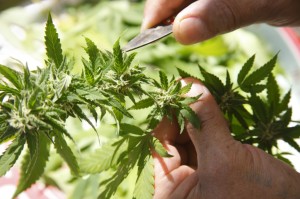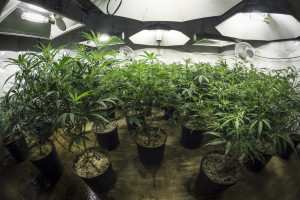 Even in the excitement of legal recreational marijuana sales rolling out in California on January 1s t, a very big problem remains: the lack of financial services. The ability for consumers to consume recreational cannabis in California is expected to bring in billions in tax revenue. Despite this massive revenue and the fact that medical marijuana has been legal for two decades, the industry is still unable to secure the financial services they to operate safely and efficiently.
Even in the excitement of legal recreational marijuana sales rolling out in California on January 1s t, a very big problem remains: the lack of financial services. The ability for consumers to consume recreational cannabis in California is expected to bring in billions in tax revenue. Despite this massive revenue and the fact that medical marijuana has been legal for two decades, the industry is still unable to secure the financial services they to operate safely and efficiently.
While business is booming – thanks to laws like Prop 64 – marijuana merchants are struggling behind the scenes. More and more people are showing up to make purchases, no longer afraid. But businesses themselves are finding it harder and harder to operate efficiently. Under federal law, cannabis is still classified as a Schedule I drug (alongside heroin and ecstasy). This status is holding these businesses back.
Even though there are federal compliance guidelines, marijuana’s federal status makes banks very wary. Unwilling to push themselves into a risky situation, they choose to stay away from the industry. Despite the industry’s booming growth.
After receiving rejection letter after rejection letter, merchants are forced to operate in cash. Without a merchant account from a bank, these businesses have no means of writing a check, doing a direct deposit or processing debt and credit card transactions. Paying bills requires only minutes of the typical business owner’s time. For the cannabis merchant, the process is not only long and overwhelming, it isE unsafe. From paying employees and bills to paying taxes, all transactions are done solely in cash.
The Internal Revenue Code Section 280E only complicates things further. This tax code was created with the intention of crippling illegal drug trafficking businesses. Since marijuana is still illegal on the federal level, this tax code affects the marijuana industry’s legal businesses.
420 College CEO, George Boyadjian, says, “It kind of cripples the business a lot. It prevents businesses from growing and reaching their full potential.”
After Prop 64 was passed, California state Treasurer John Chiang formed the Cannabis Banking Working Group. Since then, this group has been working hard on banking recommendations for the regulations scheduled to be released in 2018. The goal of this banking system is to get the most fiscally from the marijuana industry. Even so, the federal-state legality gap remains an issue, and will impact the effectiveness of this system.
“It’s not going to be a perfect pathway unless the federal government allows for this kind of activity and they take cannabis off Schedule I [status],” explains Chiang.
Many marijuana businesses continue to seek cash solutions and safe payment processing services through alternative lenders like Marijuana Merchant Account. Businesses can avoid operating in cash-only, and provide customers with multiple payment options. For merchants trying to safely and quickly pay bills, employees and taxes, this is great news. Rather than waiting for the federal government to reclassify marijuana (who knows when that might be), merchants can secure services now.


 With each state that legalizes marijuana use, opponents express their concern that it will lead to a spike in drug abuse and crime. Cannabis activists, on the other hand, continue to proclaim the benefits of legalizing marijuana. So, who is right? Or do both sides have a valid point? Will legalization hurt America’s youth by increasing drug and alcohol abuse in young people?
With each state that legalizes marijuana use, opponents express their concern that it will lead to a spike in drug abuse and crime. Cannabis activists, on the other hand, continue to proclaim the benefits of legalizing marijuana. So, who is right? Or do both sides have a valid point? Will legalization hurt America’s youth by increasing drug and alcohol abuse in young people? Next year, billions of dollars are expected to flood the California’s marijuana industry when recreational cannabis is made legal. Even so, these businesses will struggle to secure the services they need with their local banks. But why would such a profitable industry with so much potential experience issues securing solutions with a traditional lender?
Next year, billions of dollars are expected to flood the California’s marijuana industry when recreational cannabis is made legal. Even so, these businesses will struggle to secure the services they need with their local banks. But why would such a profitable industry with so much potential experience issues securing solutions with a traditional lender? As Arizona,
As Arizona,  There are simple ways to tell if a driver is drunk. There is a breathalyzer, a speech test, and a walking test. But, what happens when a policeman comes across a stoned driver? What test are there? No one — not even highway patrolmen — knows precisely how stoned a motorist can be before he’s dangerously under the influence of cannabis. Unlike with liquor, there’s no 0.08% blood alcohol equivalent for marijuana. There’s not even a common Breathalyzer to measure drugged driving. And there’s nothing around the corner. That’s one problem with rushing to legalize marijuana for stoner use.
There are simple ways to tell if a driver is drunk. There is a breathalyzer, a speech test, and a walking test. But, what happens when a policeman comes across a stoned driver? What test are there? No one — not even highway patrolmen — knows precisely how stoned a motorist can be before he’s dangerously under the influence of cannabis. Unlike with liquor, there’s no 0.08% blood alcohol equivalent for marijuana. There’s not even a common Breathalyzer to measure drugged driving. And there’s nothing around the corner. That’s one problem with rushing to legalize marijuana for stoner use. With many states offering up legalized recreational or medical pot on their ballots this week, nationwide
With many states offering up legalized recreational or medical pot on their ballots this week, nationwide  Colorado’s legalized marijuana sales in 2015 may have hit two major records. While the numbers are not yet certain, the Colorado Marijuana Enforcement Division believes that the legalized products brought in over $900 million in 2015, doubling 2014’s numbers. The other big number belongs to the tax revenue for the state that the marijuana sales brought in 2015, which is upwards of $80 million. These numbers alone should legitimize the industry, but many still are wary of it.
Colorado’s legalized marijuana sales in 2015 may have hit two major records. While the numbers are not yet certain, the Colorado Marijuana Enforcement Division believes that the legalized products brought in over $900 million in 2015, doubling 2014’s numbers. The other big number belongs to the tax revenue for the state that the marijuana sales brought in 2015, which is upwards of $80 million. These numbers alone should legitimize the industry, but many still are wary of it.
 Luckily for the marijuana industry, the legalization is voted in by each state. 22 state currently have some form of legalization, and like any law, not all citizens are pro-marijuana. Lawmakers and citizens on both sides are teaming up, fighting for tougher regulations or more relaxed regulations. Throughout this process, the industry has been growing, providing state revenues that few other industries can touch. This leads to major problems for new and existing merchants, and the riskiness of this industry is far from changing.
Luckily for the marijuana industry, the legalization is voted in by each state. 22 state currently have some form of legalization, and like any law, not all citizens are pro-marijuana. Lawmakers and citizens on both sides are teaming up, fighting for tougher regulations or more relaxed regulations. Throughout this process, the industry has been growing, providing state revenues that few other industries can touch. This leads to major problems for new and existing merchants, and the riskiness of this industry is far from changing. Legalized marijuana has brought a lot of changes to the twenty-two states have offer it. From increased tax revenues, to less drug crime, to more creative pot products, the changes are endless. Other issues were not great, such as the lack of trained employees and lack of
Legalized marijuana has brought a lot of changes to the twenty-two states have offer it. From increased tax revenues, to less drug crime, to more creative pot products, the changes are endless. Other issues were not great, such as the lack of trained employees and lack of 